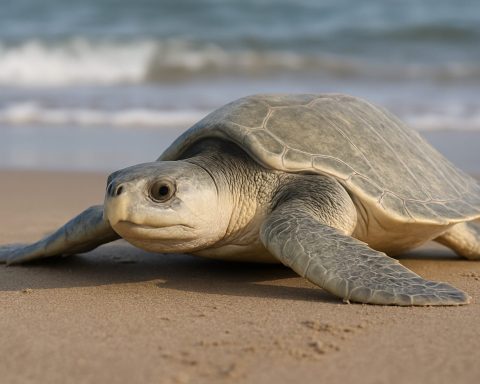Inside the Urgent Battle to Save Kemp’s Ridley Sea Turtles: Conservation Breakthroughs, Challenges, and Hope for the World’s Rarest Marine Turtle
- Introduction: The Plight of the Kemp’s Ridley Sea Turtle
- Historical Decline and Current Population Status
- Major Threats: Poaching, Bycatch, and Habitat Loss
- Conservation Strategies and Success Stories
- Nesting Sites: Protection and Monitoring Efforts
- International Collaboration and Policy Initiatives
- Community Involvement and Education Programs
- Research Innovations: Tracking and Genetic Studies
- Future Outlook: Challenges and Opportunities Ahead
- How You Can Help: Supporting Kemp’s Ridley Conservation
- Sources & References
Introduction: The Plight of the Kemp's Ridley Sea Turtle
The Kemp’s ridley sea turtle (Lepidochelys kempii) is the world’s most endangered sea turtle species, facing a precarious future due to a combination of human-induced and natural threats. Native primarily to the Gulf of Mexico, with occasional nesting along the Atlantic coast, this small marine turtle is renowned for its unique mass nesting behavior known as “arribada.” However, over the past century, populations have plummeted, with estimates suggesting a decline from tens of thousands of nesting females in the 1940s to just a few hundred by the mid-1980s. The primary drivers of this decline include egg harvesting, incidental capture in fishing gear (bycatch), habitat loss, and environmental disasters such as oil spills. Climate change and marine pollution further exacerbate these challenges, threatening both nesting beaches and oceanic habitats.
Conservation efforts for the Kemp’s ridley have been extensive and collaborative, involving international treaties, government agencies, non-profit organizations, and local communities. Initiatives such as nest protection, head-start programs, and the implementation of turtle excluder devices (TEDs) in fisheries have contributed to a slow but hopeful recovery in recent decades. Despite these efforts, the species remains classified as Critically Endangered by the International Union for Conservation of Nature and is protected under the U.S. Fish & Wildlife Service Endangered Species Act. The ongoing plight of the Kemp’s ridley sea turtle underscores the urgent need for sustained conservation action and international cooperation to ensure its survival for future generations.
Historical Decline and Current Population Status
The Kemp’s ridley sea turtle (Lepidochelys kempii) has experienced one of the most dramatic population declines among marine turtles. Historically, this species was abundant in the Gulf of Mexico, with nesting events—known as arribadas—numbering in the tens of thousands at the primary nesting beach in Rancho Nuevo, Mexico during the 1940s. However, by the mid-1980s, annual nest counts had plummeted to fewer than 300, signaling a catastrophic decline. The primary drivers of this collapse were intensive egg harvesting, incidental capture in shrimp trawls, and habitat degradation (NOAA Fisheries).
Conservation efforts initiated in the late 20th century, including nest protection, head-starting programs, and the implementation of Turtle Excluder Devices (TEDs) in fisheries, have contributed to a slow but notable recovery. Nesting numbers increased steadily from the 1990s through the early 2000s, peaking at over 22,000 nests in 2012. However, a concerning decline was observed after 2013, with nest counts dropping and fluctuating since then (U.S. Fish & Wildlife Service).
Today, the Kemp’s ridley remains the world’s most endangered sea turtle. The global population is estimated at only a fraction of its historical size, and the species is classified as Critically Endangered. Ongoing threats include bycatch, climate change, and habitat loss, underscoring the need for sustained and adaptive conservation strategies (IUCN Red List).
Major Threats: Poaching, Bycatch, and Habitat Loss
Kemp’s Ridley sea turtles face a precarious future due to a combination of human-induced threats, with poaching, bycatch, and habitat loss being the most significant. Historically, poaching of eggs and adult turtles for consumption and trade decimated populations, particularly at their primary nesting beaches in Mexico. Despite legal protections and increased enforcement, illegal collection still occurs, undermining recovery efforts (U.S. Fish & Wildlife Service).
Bycatch in commercial and artisanal fisheries remains a critical threat. Kemp’s Ridleys are especially vulnerable to incidental capture in shrimp trawls, gillnets, and longlines. Even with the implementation of Turtle Excluder Devices (TEDs), compliance and effectiveness vary, and thousands of turtles are estimated to die annually as a result (NOAA Fisheries). These accidental captures not only cause direct mortality but also contribute to injuries and stress that can reduce reproductive success.
Habitat loss further compounds these threats. Coastal development, beach erosion, and pollution degrade critical nesting and foraging habitats. Light pollution from beachfront properties disorients hatchlings, leading them away from the ocean and increasing mortality rates. Additionally, climate change exacerbates habitat loss through rising sea levels and increased storm frequency, which can wash away nests and alter sand temperatures, affecting hatchling sex ratios (International Union for Conservation of Nature).
Addressing these threats requires coordinated international conservation efforts, strict enforcement of protective regulations, and ongoing public education to ensure the survival of this critically endangered species.
Conservation Strategies and Success Stories
Conservation strategies for the Kemp’s ridley sea turtle (Lepidochelys kempii), the world’s most endangered sea turtle, have evolved through international collaboration, scientific research, and community engagement. One of the most significant strategies has been the protection of nesting beaches, particularly at Rancho Nuevo in Tamaulipas, Mexico, where the majority of the global population nests. Since the 1970s, efforts led by the Secretaría de Medio Ambiente y Recursos Naturales (SEMARNAT) and supported by organizations such as the U.S. Fish and Wildlife Service have included patrolling beaches, relocating eggs to protected hatcheries, and releasing hatchlings to the sea to increase survival rates.
Another key strategy has been the implementation of Turtle Excluder Devices (TEDs) in shrimp trawl fisheries, mandated by the National Oceanic and Atmospheric Administration (NOAA) and international agreements. TEDs significantly reduce accidental bycatch, a major threat to Kemp’s ridleys. Additionally, binational agreements between the U.S. and Mexico have fostered coordinated research, monitoring, and public education campaigns.
These combined efforts have yielded notable success. After reaching a critical low in the mid-1980s, with fewer than 300 nesting females recorded, the population showed signs of recovery, with thousands of nests documented in recent years. While the species remains critically endangered, these conservation measures demonstrate the effectiveness of targeted, science-based interventions and international cooperation in reversing the decline of Kemp’s ridley sea turtles International Union for Conservation of Nature (IUCN).
Nesting Sites: Protection and Monitoring Efforts
Nesting site protection and monitoring are critical components of Kemp’s Ridley sea turtle conservation, given the species’ highly restricted nesting range, primarily along the Gulf coast of Mexico and Texas. The most significant nesting beach is Rancho Nuevo in Tamaulipas, Mexico, where the majority of the global population comes ashore in synchronized mass nesting events known as arribadas. To safeguard these vital sites, conservationists implement a range of protective measures, including patrolling beaches to deter poaching, relocating vulnerable nests to hatcheries, and installing barriers to prevent predation by animals such as raccoons and coyotes. These efforts are coordinated by organizations and government agencies, such as the Comisión Nacional de Áreas Naturales Protegidas (CONANP) in Mexico and the U.S. Fish and Wildlife Service in the United States.
Monitoring programs are equally essential, involving the systematic collection of data on nest numbers, hatching success rates, and threats to eggs and hatchlings. Volunteers and scientists conduct daily patrols during nesting season, tagging females and recording nesting events to track population trends. These data inform adaptive management strategies and help evaluate the effectiveness of conservation interventions. Additionally, public education campaigns and community involvement are integral, fostering local stewardship and reducing human disturbances on nesting beaches. The collaborative, binational approach to nesting site protection has been instrumental in the gradual recovery of Kemp’s Ridley populations, though continued vigilance is necessary due to ongoing threats such as climate change, coastal development, and incidental capture in fisheries (NOAA Fisheries).
International Collaboration and Policy Initiatives
International collaboration and policy initiatives have been pivotal in the ongoing conservation efforts for the critically endangered Kemp’s ridley sea turtle (Lepidochelys kempii). Given the species’ transboundary migratory patterns, particularly between the United States and Mexico, bilateral agreements and coordinated actions are essential. The 1987 U.S. Fish & Wildlife Service and the Mexican government launched a binational recovery plan, which established joint nesting beach protection, egg relocation programs, and standardized monitoring protocols. This collaboration has led to increased nest protection and hatchling success rates on key beaches such as Rancho Nuevo in Tamaulipas, Mexico.
International policy frameworks, such as the Convention on International Trade in Endangered Species of Wild Fauna and Flora (CITES), have also played a crucial role by prohibiting international trade in Kemp’s ridley turtles and their eggs. Additionally, the Inter-American Convention for the Protection and Conservation of Sea Turtles (IAC) fosters regional cooperation among Western Hemisphere nations, promoting best practices in fisheries management and habitat protection.
Despite these advances, challenges remain, including bycatch in fisheries, habitat degradation, and climate change. Ongoing international dialogue and adaptive policy measures are necessary to address emerging threats. Strengthening enforcement, expanding community engagement, and enhancing scientific exchange are key priorities identified by both governmental and non-governmental stakeholders to ensure the long-term survival of the Kemp’s ridley sea turtle.
Community Involvement and Education Programs
Community involvement and education programs are pivotal in the conservation of Kemp’s Ridley sea turtles, the world’s most endangered sea turtle species. Local communities, especially those near nesting beaches in Mexico and the United States, play a crucial role in protecting nesting sites, reporting strandings, and reducing threats such as poaching and habitat disturbance. Grassroots initiatives often include volunteer patrols during nesting season, where residents and visitors help monitor beaches, relocate vulnerable nests, and assist hatchlings in reaching the ocean safely.
Education programs, both formal and informal, are designed to raise awareness about the plight of Kemp’s Ridley turtles and foster stewardship among diverse audiences. Schools, aquariums, and conservation organizations develop curricula, workshops, and outreach events that highlight the species’ life cycle, threats, and the importance of healthy marine ecosystems. These efforts are complemented by public campaigns that encourage responsible fishing practices, reduction of plastic waste, and reporting of turtle sightings or strandings.
Collaborative projects, such as the U.S. Fish & Wildlife Service’s recovery initiatives and the National Park Service’s community-based conservation at Padre Island National Seashore, demonstrate the effectiveness of integrating local knowledge with scientific research. These programs not only enhance turtle survival rates but also empower communities to become long-term advocates for marine conservation.
Research Innovations: Tracking and Genetic Studies
Recent advancements in research methodologies have significantly enhanced the conservation efforts for Kemp’s Ridley sea turtles, the world’s most endangered sea turtle species. Satellite telemetry has revolutionized the ability to track individual turtles across vast oceanic distances, providing critical data on migratory routes, foraging grounds, and nesting site fidelity. These insights have informed the establishment of protected areas and the timing of conservation interventions, such as seasonal fishing restrictions to reduce bycatch. For example, satellite tracking has revealed previously unknown migratory corridors between nesting beaches in Mexico and feeding areas in the Gulf of Mexico and the U.S. Atlantic coast, underscoring the need for international cooperation in conservation strategies (NOAA Fisheries).
Genetic studies have also played a pivotal role in Kemp’s Ridley conservation. By analyzing mitochondrial DNA and nuclear markers, researchers have been able to assess genetic diversity, population structure, and connectivity among nesting colonies. These studies have confirmed that the primary nesting population at Rancho Nuevo, Mexico, is genetically distinct, highlighting the critical importance of this site for species recovery. Furthermore, genetic fingerprinting has enabled the identification of natal origins for stranded or bycaught turtles, helping to pinpoint threats and prioritize management actions (U.S. Geological Survey).
Together, these research innovations provide a scientific foundation for adaptive management, allowing conservationists to respond more effectively to emerging threats and to measure the success of recovery efforts for Kemp’s Ridley sea turtles.
Future Outlook: Challenges and Opportunities Ahead
The future of Kemp’s Ridley sea turtle conservation is shaped by a complex interplay of persistent challenges and emerging opportunities. Despite decades of dedicated recovery efforts, including nest protection, head-starting programs, and international cooperation, the species remains critically endangered, with annual nest counts fluctuating and recent years showing concerning declines U.S. Fish & Wildlife Service. Key challenges include ongoing threats from bycatch in fisheries, habitat loss due to coastal development, and the impacts of climate change, such as rising sand temperatures that can skew hatchling sex ratios and increase nest failure rates NOAA Fisheries.
However, there are significant opportunities to bolster conservation outcomes. Advances in satellite tracking and genetic research are improving understanding of migration patterns and population structure, enabling more targeted protection measures. International collaboration, particularly between the United States and Mexico, remains vital for safeguarding nesting beaches and migratory corridors Comisión Nacional de Áreas Naturales Protegidas. Additionally, community engagement and ecotourism initiatives offer sustainable economic incentives for local populations to participate in conservation.
Looking ahead, adaptive management strategies that incorporate climate resilience, stricter fisheries regulations, and expanded public education will be essential. Continued funding and political will are critical to ensure that the Kemp’s Ridley sea turtle not only survives but thrives in the face of evolving environmental pressures.
How You Can Help: Supporting Kemp's Ridley Conservation
Individuals can play a vital role in supporting Kemp’s Ridley sea turtle conservation through a variety of actions, both locally and globally. One of the most direct ways to help is by supporting organizations dedicated to sea turtle research, rescue, and habitat protection. Donations to reputable groups such as the U.S. Fish & Wildlife Service and the National Park Service help fund critical nesting beach patrols, rehabilitation of injured turtles, and public education campaigns.
Volunteering is another impactful way to contribute. Many coastal communities offer opportunities to participate in beach cleanups, nest monitoring, and hatchling releases. These activities not only protect nesting sites from pollution and disturbance but also raise awareness about the threats facing Kemp’s Ridley turtles. For those living far from nesting beaches, advocating for policies that reduce marine debris, regulate fisheries, and protect coastal habitats can make a significant difference. Contacting legislators and supporting conservation-friendly legislation through organizations like the World Wildlife Fund amplifies the collective voice for sea turtle protection.
Finally, making sustainable choices in daily life—such as reducing single-use plastics, choosing sustainable seafood, and spreading awareness about sea turtle conservation—can help address some of the root causes of population decline. By taking these steps, individuals become active participants in the global effort to ensure the survival of the Kemp’s Ridley sea turtle.
Sources & References
- International Union for Conservation of Nature
- U.S. Fish & Wildlife Service
- NOAA Fisheries
- International Union for Conservation of Nature
- Secretaría de Medio Ambiente y Recursos Naturales (SEMARNAT)
- National Park Service
- NOAA Fisheries













